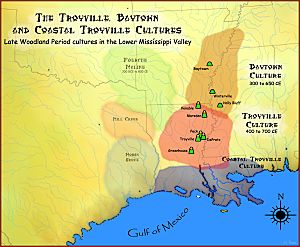Baytown culture facts for kids

The Baytown culture was a group of Native American people who lived a long time ago, between the years 300 and 700 CE. They lived in the lower Mississippi River Valley. This area includes parts of eastern Arkansas, western Tennessee, Louisiana, and western Mississippi.
The main place where we learned about them is called the Baytown Site. It's located on the White River in Monroe County, Arkansas. The Baytown culture was part of the Late Woodland period. They lived at the same time as the Coastal Troyville and Troyville cultures. All three cultures developed from the Marksville Hopewellian peoples. The Baytown culture was later followed by the Plum Bayou culture. Baytown people lived in spread-out settlements. The Troyville people, however, kept building large earth mounds.
Changes in Ancient Cultures
Historians and archaeologists used to think that the Late Woodland period (about 1,500 to 1,000 years ago) was a time when cultures became less advanced. This was because earlier groups, like the Hopewell people, had created amazing art and large sites. Late Woodland sites often seem smaller. But there are several ideas about why things changed:
- Sometimes, populations grew too large for the land to support everyone. When old trade systems broke down, groups might have raided other areas instead of trading for important resources.
- The invention of the bow and arrow made hunting much easier. This might have led to fewer large game animals. As a result, people may have split into smaller groups to find food more easily.
- The climate became colder about 1,600 years ago. This could have affected how well wild foods, like nuts and seeds, grew.
- Farming became very successful. Growing more food might have meant that different areas had similar amounts of food. However, relying on just a few types of plants could be risky. If there wasn't enough rain, it could cause food shortages.
It's likely that all these reasons worked together to shape the Baytown culture. Even though there aren't many famous artworks from this time, the Late Woodland period was very active. New tools like the bow and arrow made hunting better. New types of corn, beans, and squash became important foods. These new crops added to the wild plants and roots people already ate. Even though settlements were small, there were more Late Woodland sites than Middle Woodland sites. This suggests that the population actually grew. These changes show that the Late Woodland period was a time of growth, not a cultural collapse.
Daily Life and Tools
What Baytown People Ate
The Baytown people grew many plants that were native to eastern North America. These included maygrass, little barley, amaranth, and chenopodium. They also grew smaller amounts of sunflower, sumpweed, knotweed, squash, and bottle gourd.
Wild foods were also very important. They ate acorns and hickory nuts. They also gathered wild fruits like persimmons, plums, cherries, different berries, and grapes.
For hunting, they used bows and arrows. They hunted animals like white-tailed deer, squirrels, raccoons, turkeys, and passenger pigeons. They also caught migratory wild birds. From nearby waters, they caught various kinds of fish and aquatic turtles.
Baytown Pottery
The Baytown culture is known for its special pottery. They made flat-based jars and bowls that were shaped like half-spheres. They also made stone points for their atlatl darts. An atlatl is a tool used to throw spears with more force.
The Plum Bayou culture later developed from the Baytown culture. There isn't a clear line between the two. They existed at the same time for a while. Pottery designs from the Plum Bayou culture have been found at the Baytown Site. This shows that the site was still used after the year 650 CE. Some types of pottery found there include Mulberry Creek Cord Marked, Larto Red, Coles Creek Incised, and Officer Punctated ceramics.

